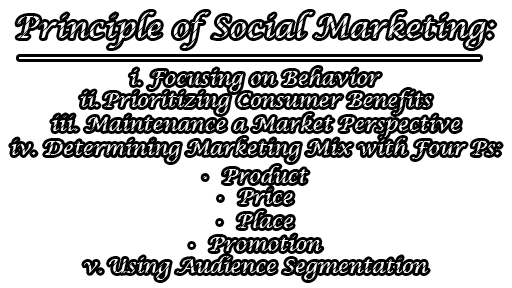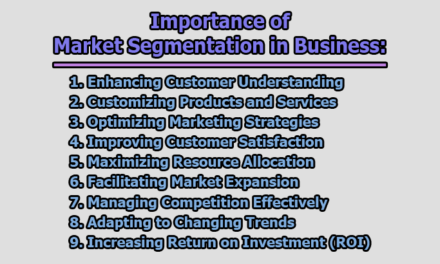Social marketing is one of the most common terms in this modern age. The concept of social marketing has had enormous appeal for health promotion and social change programs. Social marketing creates awareness among societies. Social marketing is an approach to social and behavioral change. In this article, we are going to present to you the principle of social marketing and the difference between social marketing and commercial marketing.
Social marketing is “a socially influenced technology involving the design, implementation, and control of programs aimed at increasing the acceptability of a social idea or practice in one or more groups of target adopters.” (Kotler and Roberto)
“Social marketing is the application of commercial marketing technologies to the analysis, planning, execution, and education of programs designed to influence the voluntary behavior of target audience in order to improve their personal welfare and that of their society.” (Andreasen)
Principle of Social Marketing:
Some of the basic principles that have made social marketing popular and effective are as follows:
i. Focusing on Behavior: The proper objective of social marketing is to influence behavior. It is not enough to promote products or services, people must use and obtain them. In the commercial world, soft drinking manufactures would fail if their business goods were merely to promote awareness of or positive attitude towards their products, consumers must act to purchase them. In social marketing, the use of the product is of much greater importance because the use usually confers the benefit. For example; a condom marketing campaign would have to be judged unsuccessful, even if millions of condoms were distributed if they were not used as they were meant to be – to prevent disease and pregnancy.
ii. Prioritizing Consumer Benefits: Social marketing programs popularly focus on the benefits of the consumers and not on the benefits of the organization marketing the products or services. Although consumers may get benefits from commercial advertising and marketing campaigns. In contrast, social marketing campaigns benefit members of the audience or society at large in the form of better health. For example; a health campaign organized by the government agencies and consumers changes their health behavior.
iii. Maintenance a Market Perspective: Another principle of social marketing is that sets, which apart from other forms of the market itself. First, a market perspective implies the adaptation of consumer orientation. Second, the functioning of the market is dependent on the communication of information about available products. Third, promoted products always face competition for the consumer’s attention and resources in a dynamic marketplace of ideas, priorities, and choices.
iv. Determining Marketing Mix with Four Ps: Another distinguishing characteristic of social marketing approach in consideration of the proper marketing mix with the four Ps; Product, Price, Place, and Promotion. These are briefly described below:
- Product: Rather than thinking of products as physical objects, for example; hygiene products, seat belts, recycling centers, marketers think of them as the constellation of benefits that can be offered to consumers to make using those products enticing. The attributes or benefits that define a product in the mind of the consumer may be physical, economic, social, and psychological.
- Price: Price refers to the perceived cost or barriers associated with the product being offered. Cost can be monetary, social, or psychological. For example; consider a campaign to increase the practice among backyard poultry farmers of caging their chickens to prevent the birds and people who work with them from becoming infected with the H5N1 virus. Free-ranging of chickens is generally cheaper than keeping birds caged. Social marketing promoting among other things, low-cost caging using local material as behavior that not only protects the farmer’s economic investment but also protests the health of their family.
- Place: Place refers to where the customer is reached with the products and information about it and where the voluntary take place. Convenience may include such things as the location of the product in physical or virtual space. In the case of commercial products, a place might include a retail outlet, door-to-door delivery, or non-traditional social networks.
- Promotion: Promotion refers to the communication and messaging elements of social marketing programs. Promotional strategies typically provide information about the other Ps such as the salient features of the product and the cost, benefits the customer can expect, where the product can be obtained, etc. different consumer groups may respond to one promotional strategy than to another.
v. Using Audience Segmentation: The principle of audience segmentation refers to the identification of relatively homogeneous sub-groups and the development of marketing strategies customized to the unique characteristics of each sub-groups. Different sub-groups require different strategies because they may value different benefits associated with the product. For example; consider an adolescent reproductive health campaign focused on reducing teenage pregnancy.
Difference between Social Marketing and Commercial Marketing:
Some of the common differences are as follows:
- Primary Locus of Benefit: Social marketing considers individuals, social and leaders, professionals, society at large whereas commercial marketing considers marketing organization, producer of the marketed goods.
- Products: In social marketing selling depends on the desired behavior on the other hand commercial marketing depends on the selling of tangible goods and services.
- Primary objectives: Social marketing helps to get societal benefit in terms of social gain while commercial marketing satisfies customers by selling products to them and fulfilling their needs and earning profit.
- Focus: Social marketing focuses to reach the target audience and change the behavior whereas commercial marketing focuses on physical products or services.
- Marketing tools: Tools are used for changing behavior in social marketing however tools are used for selling products in commercial marketing.
- Satisfying needs: In social marketing, marketers get satisfied to fulfill society’s needs but marketers get satisfied to fulfill individual needs in commercial marketing.
- Competition: Audiences’ current or preferred behavior and associated benefits in social marketing while other organizations offer similar goods and services in commercial marketing.
- Driver: Social marketing convinces someone that a particular behavior is bad and to do something that she/he may not want to do, in contrast, commercial marketing creates and exchanges products that people want or need.
- Voluntary exchange: More emphasis on non-monetary exchange in social marketing whereas more emphasis on monetary exchange in commercial marketing.
- Market perspective: In social marketing, products tend to be less tangible and more complex wherein commercial marketing products tend to be more tangible.
From the above discussion, we can say that social marketing is a good concept or idea that helps to aware people of society. Commercial marketing is totally different from it, but it also helps to build an economical structure of a country.

Library Lecturer at Nurul Amin Degree College










